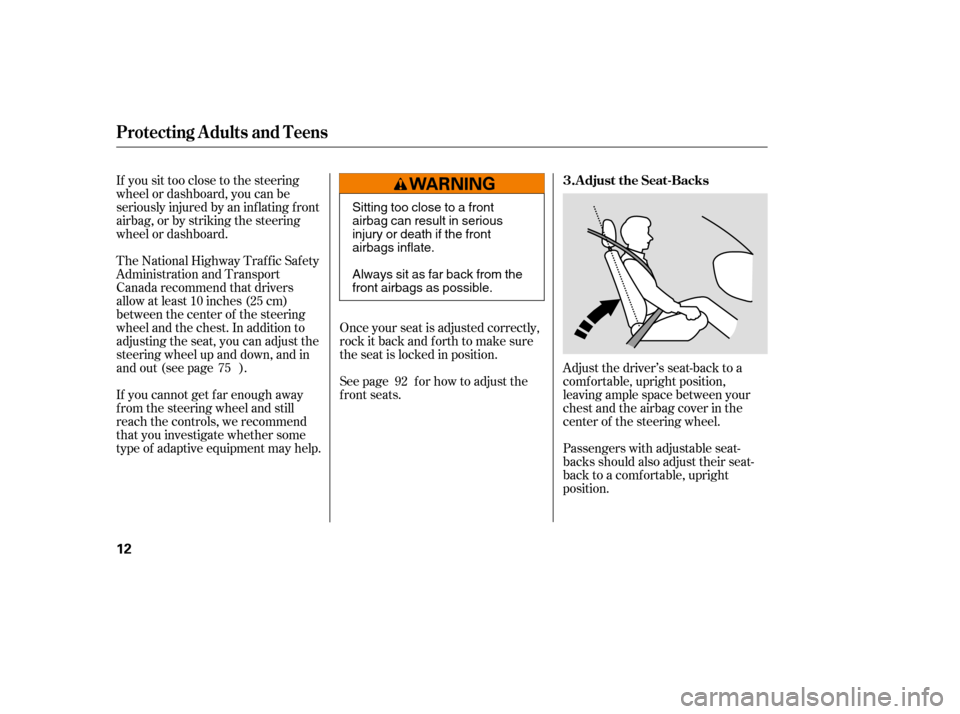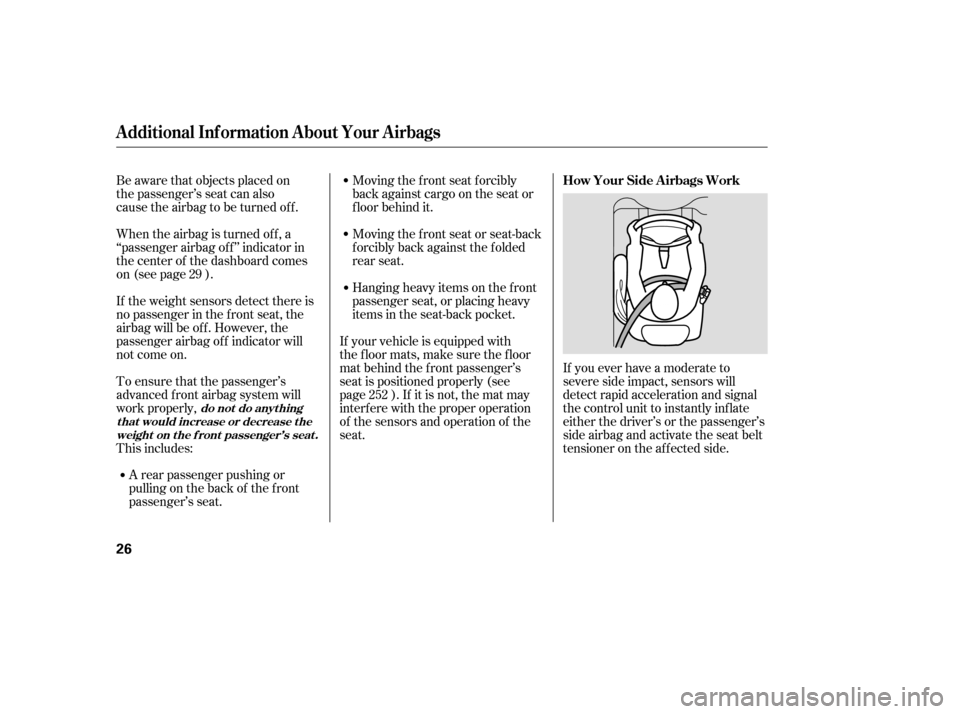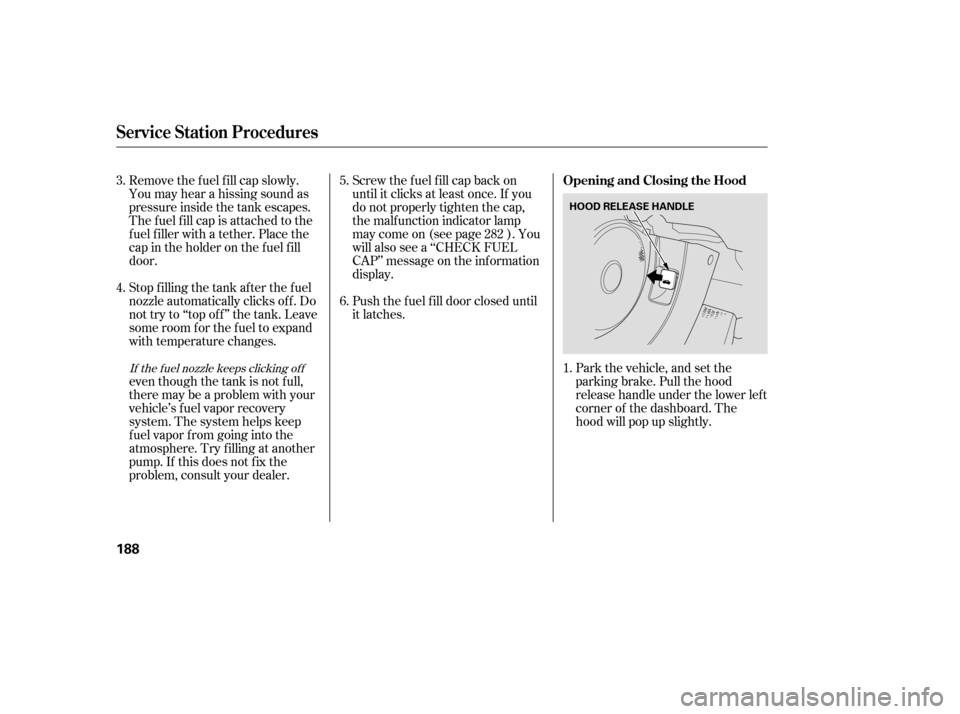Page 2 of 413

If you sit too close to the steering
wheel or dashboard, you can be
seriously injured by an inf lating f ront
airbag, or by striking the steering
wheel or dashboard.Once your seat is adjusted correctly,
rock it back and f orth to make sure
the seat is locked in position.
See page f or how to adjust the
f ront seats.Adjust the driver’s seat-back to a
comf ortable, upright position,
leaving ample space between your
chest and the airbag cover in the
center of the steering wheel.
Passengers with adjustable seat-
backs should also adjust their seat-
back to a comf ortable, upright
position.
If you cannot get f ar enough away
f rom the steering wheel and still
reach the controls, we recommend
that you investigate whether some
type of adaptive equipment may help.
The National Highway Traffic Safety
Administration and Transport
Canada recommend that drivers
allow at least 10 inches (25 cm)
between the center of the steering
wheel and the chest. In addition to
adjusting the seat, you can adjust the
steering wheel up and down, and in
and out (see page ).
75
92
Protecting A dults and T eens
Adjust the Seat-Backs
3.
12
Sitting too close to a front
airbag can result in serious
injury or death if the front
airbags inflate.
Always sit as far back from the
front airbags as possible.
�����—�����—�
�
�y�
�������������y���
�(�+���������y�����
���y
Page 5 of 413

During a frontal crash, your seat belt
restrains your lower body and torso,
and the f ront airbag helps protect
your head and chest.
Although both airbags normally
inf late within split second of each
other, it is possible f or only one
airbag to deploy.
This can happen if the severity of a
collision is at the margin, or
threshold, that determines whether
or not the airbags will deploy. In
such cases, the seat belt will provide
suf f icient protection, and the
supplemental protection of f ered by
the airbag would be minimal.
Only the driver’s airbag will deploy if
there is no passenger in the f ront
seat, or if the advanced airbag
system has turned the passenger’s
airbag off (see page ).
If you ever have a moderate to
severe f rontal collision, sensors will
detect the vehicle’s rapid
deceleration.
If the rate of deceleration is high
enough, the control unit will instantly
inf late the driver’s and f ront
passenger’s airbags, at the time and
with the f orce needed.
Emergency backup power in case
your vehicle’s electrical system is
disconnected in a crash.
An indicator on the dashboard that
alerts you that the passenger’s
f ront airbag has been turned of f
(see page ).
An indicator on the instrument
panel that alerts you that the
passenger’s side airbag has been
turned of f (see page ).
25
29
29
CONT INUED
Additional Inf ormation About Your Airbags
How Your Front A irbags Work
Driver and Passenger Saf ety
23
�����—�����—�
�
�y�
����
����
���y���
�(�+���������y���������y
Page 8 of 413

Moving the f ront seat f orcibly
back against cargo on the seat or
f loor behind it.
A rear passenger pushing or
pulling on the back of the f ront
passenger’s seat.
To ensure that the passenger’s
advanced front airbag system will
work properly,
This includes:
If the weight sensors detect there is
no passenger in the f ront seat, the
airbag will be off. However, the
passenger airbag of f indicator will
not come on.
When the airbag is turned of f , a
‘‘passenger airbag of f ’’ indicator in
the center of the dashboard comes
on (see page ).
Be aware that objects placed on
the passenger’s seat can also
cause the airbag to be turned of f .
Moving the front seat or seat-back
f orcibly back against the f olded
rear seat.
If you ever have a moderate to
severe side impact, sensors will
detect rapid acceleration and signal
the control unit to instantly inf late
either the driver’s or the passenger’s
side airbag and activate the seat belt
tensioner on the af f ected side.
Hanging heavy items on the f ront
passenger seat, or placing heavy
items in the seat-back pocket.
If your vehicle is equipped with
thefloormats,makesurethefloor
matbehindthefrontpassenger’s
seat is positioned properly (see
page ). If it is not, the mat may
interf ere with the proper operation
of the sensors and operation of the
seat.
29
252 How Your Side A irbags Work
Additional Inf ormation About Your Airbags
do not do anyt hing
t hat would increase or decrease t he
weight on t he f ront passenger’s seat .
26
�����—�����—�
�
�y�
����
��������y���
�(�+���������y�������
�y
Page 10 of 413
�µ
To remind you of the passenger’s
f ront airbag hazards, and that
children must be properly restrained
in a back seat, your vehicle has
warninglabelsonthedashboard
(U.S. models) and on the f ront visors.
Please read and follow the
instructions on these labels.U.S. ModelsCanadian Models
Protecting Children General Guidelines
34
SUN VISOR
SUN VISOR
DASHBOARD
�����—�����—�
�
�y�
����
�
������y���
�(�+���������y���������y
Page 17 of 413
CONT INUED
These labels are in the locations
shown. They warn you of potential
hazards that could cause serious
injury or death. Read these labels
caref ully.
If a label comes of f or becomes hard
to read (except for the U.S.
dashboard label which may be
removed by the owner), contact your
dealer f or a replacement.U.S. models
U.S. models only
Canadian models
Saf ety L abels
Driver and Passenger Saf ety
51
RADIATOR CAP SUN VISOR
DASHBOARD
�����—�����—�
�
�y�
����
����
���y���
�(�+���������y���������y
Page 45 of 413

Park the vehicle, and set the
parking brake. Pull the hood
release handle under the lower lef t
corner of the dashboard. The
hood will pop up slightly.
Screw the f uel f ill cap back on
until it clicks at least once. If you
do not properly tighten the cap,
the malf unction indicator lamp
maycomeon(seepage ).You
will also see a ‘‘CHECK FUEL
CAP’’ message on the inf ormation
display.
Push the f uel f ill door closed until
it latches.
Remove the f uel f ill cap slowly.
You may hear a hissing sound as
pressure inside the tank escapes.
The fuel fill cap is attached to the
f uel f iller with a tether. Place the
cap in the holder on the f uel f ill
door.
Stop f illing the tank af ter the f uel
nozzle automatically clicks of f . Do
not try to ‘‘top off’’ the tank. Leave
some room f or the f uel to expand
with temperature changes.
even though the tank is not f ull,
there may be a problem with your
vehicle’s fuel vapor recovery
system. The system helps keep
f uel vapor f rom going into the
atmosphere. Try f illing at another
pump. If this does not f ix the
problem, consult your dealer.
1.
5. 6.
4.
3.
282If the f uel nozzle keeps clicking of f
Service Station Procedures
Opening and Closing the Hood
188
HOOD RELEASE HANDLE
�����—�����—�
�
�y�
�������������y���
�(�+���������y���
�����y
Page 49 of 413

If you do not perf orm the indicated
maintenance, negative mileage is
displayed and begins to blink af ter
the vehicle has been driven 10 miles
(10 km) or more.
Negative mileage means your
vehicle has passed the maintenance
required point.
Immediately have the indicated
maintenance done by your dealer.
When the remaining engine oil lif e is
0 percent, the engine oil lif e indicator
will blink. The display comes on
everytimeyouturntheignition
switch to the ON (II) position. The
maintenance minder indicator
( ) also comes on and remains
on in the instrument panel. When
you see this message, immediately
have the indicated maintenance done
by your dealer.
The maintenance item code or codes
indicate the main and sub items
required at the time of the oil change
(see page ).
You can switch the display to the
odometer, the trip meter, and the
outside temperature indicator (if
equipped) by pushing the SEL/
RESET button on the dashboard
repeatedly.
Whentheengineoillifeis15to1
percent, the maintenance minder
indicator ( ) comes on every
time you turn the ignition switch to
the ON (II) position, then it goes out
if you switch the inf ormation display.
When you see this message, have
the indicated maintenance
perf ormed by your dealer as soon as
possible.
231
CONT INUED
Maintenance Minder
Maint enance
227
NEGATIVE MILEAGE
�����—�����—�
�
�y�
���������
���y���
�(�+���������y���������y
Page 57 of 413
Your vehicle has several identif ying
numbers located in various places.
The vehicle identif ication number
(VIN) is the 17-digit number your
dealer uses to register your vehicle
f or warranty purposes. It is also
necessary f or licensing and insuring
your vehicle. The easiest place to
find the VIN is on a plate fastened to
the top of the dashboard. You can
seeitbylookingthroughthe
windshield on the driver’s side. It is
also on the certification label
attached to the driver’s doorjamb,
and is stamped on the engine
compartment bulkhead. The VIN is
also provided in bar code on the
certif ication label.
To access the VIN in the engine
compartment, slide the lid on the
back of the engine compartment.
Make sure to close the lid bef ore
closing the hood.
Identif ication Numbers
294
CERTIFICATION LABEL
VEHICLE IDENTIFICATION NUMBER
LID
�����—�����—�
�
�y�
�������������y���
�(�+���������y���������y